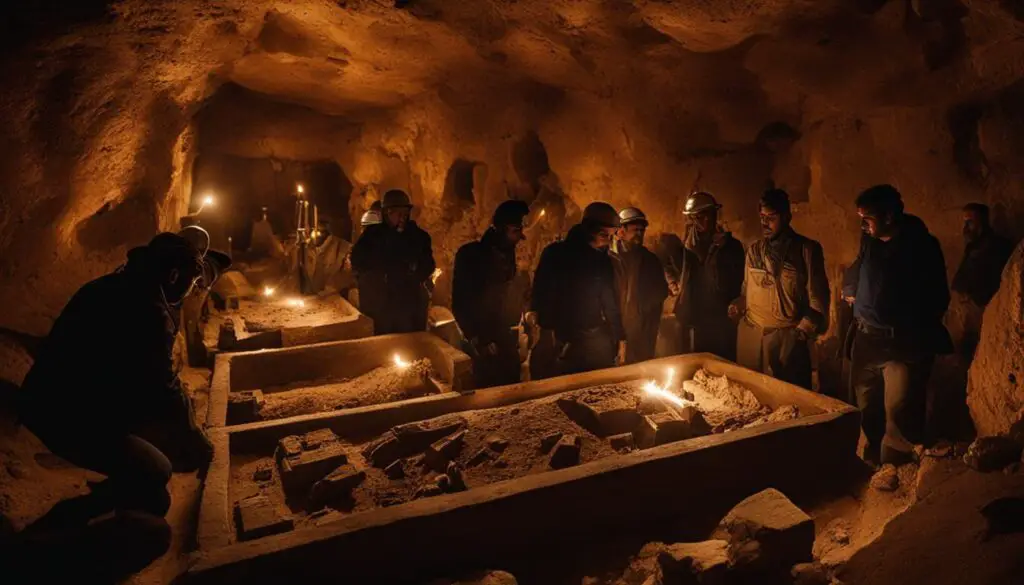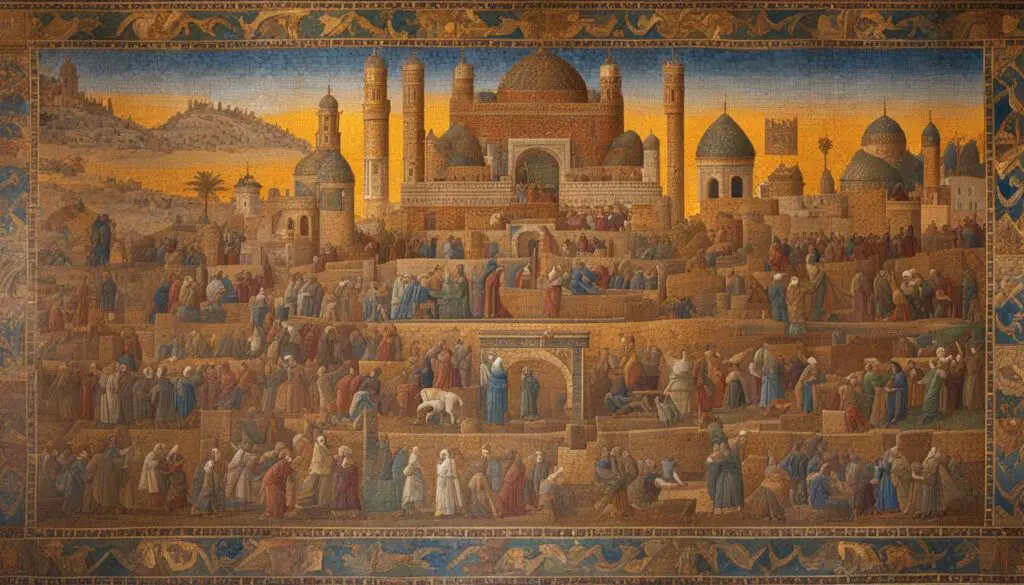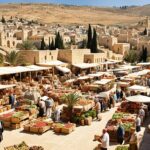Judah, also spelled Judea, holds immense biblical importance as the homeland of the Tribe of Judah, one of the twelve Israelite tribes. This region, located in the southern part of ancient Palestine, played a significant role in biblical times and continues to impact the Jewish diaspora and the wider world.
Notable biblical figures linked to Judah include St. John the Baptist, Herod, Pontius Pilate, Herod Agrippa I, and Herod Agrippa II. These individuals shaped the region’s history and left a lasting impact on Jewish heritage.
In biblical times, Judah was characterized by its diverse geographic features, with its core being the upper hill country known as Har Yehuda. Cities like Jerusalem, Bethlehem, and Hebron were significant centers within the region.
Major events such as the Siege of Masada and the First Jewish Revolt took place in Judah, shaping its history and cultural legacy.
Today, visitors can explore the rich history and cultural heritage of Judah through archaeological sites and cultural experiences. These experiences allow individuals to connect with the biblical past and gain a deeper understanding of the Jewish people and their history.
Key Takeaways:
- Judah holds immense biblical importance as the homeland of the Tribe of Judah.
- Notable biblical figures linked to Judah include St. John the Baptist, Herod, and Pontius Pilate.
- Judah was characterized by diverse geographic features, with Jerusalem, Bethlehem, and Hebron being significant cities.
- Major events in biblical times, such as the Siege of Masada and the First Jewish Revolt, shaped Judah’s history.
- Today, visitors can explore the rich history and cultural heritage of Judah through archaeological sites.
The Geographic Features and Boundaries of Judah
Judah, also known as Judea, was a region in biblical times located in the southern part of ancient Palestine. It was characterized by diverse geographic features that shaped its boundaries and played a significant role in its historical development. At its core, Judah encompassed the upper hill country known as Har Yehuda, extending south from the region of Bethel to Beersheba.
The region of Judah was originally inhabited by the Canaanites, with Hebron serving as an important center. However, when the Israelites conquered the land, the Tribe of Judah laid claim to the entire area, which stretched from just south of Jerusalem to the Negev region. Jerusalem, situated within the boundaries of Judah, became the capital of the united kingdom under King David and maintained its status as the capital of the Kingdom of Judah until its destruction by the Babylonians.
Other notable cities within the region of Judah included Bethlehem and Hebron. Bethlehem, known as the birthplace of King David and the ancestral home of the biblical figure Ruth, held significant religious and cultural importance. Hebron, on the other hand, was a major center believed to have been established during the time of Abraham and served as the burial place of several prominent biblical figures, including Abraham, Isaac, and Jacob.
| Region | Boundaries | Significant Cities |
|---|---|---|
| Har Yehuda | Extending south from the region of Bethel to Beersheba | – |
| Judah proper | From just south of Jerusalem to the Negev region | Jerusalem (capital), Bethlehem, Hebron |
| Hebron | – | Hebron (major center) |
The Rise and Fall of the Kingdom of Judah
The Kingdom of Judah emerged as a separate entity from the Kingdom of Israel around the 10th century BCE. Under the reigns of King David and King Solomon, Judah experienced a period of prosperity and prominence. David, known for his victory over Goliath, established Jerusalem as the capital and brought political stability to the region. Solomon, renowned for his wisdom and the construction of the First Temple in Jerusalem, further solidified Judah’s power.
However, after Solomon’s death, the kingdom faced internal conflicts, and the ten northern tribes separated from Judah, forming the Kingdom of Israel. This division weakened both kingdoms and made them vulnerable to outside threats. In the late 8th century BCE, the northern tribes of Israel fell to the Neo-Assyrian Empire, leaving Judah as the surviving kingdom. Yet, Judah’s independence was short-lived.
In 586 BCE, the Babylonians, under the rule of King Nebuchadnezzar II, conquered Judah and destroyed the First Temple in Jerusalem. The Babylonian exile began, and many Jews were forced to leave their homeland and live in captivity. This period marked a significant turning point in the history of Judah.
The Babylonian exile lasted for several decades until the Persians, under the leadership of King Cyrus the Great, conquered Babylon. Cyrus issued a decree allowing the exiled Jews to return to their homeland and rebuild the temple in Jerusalem. This marked the beginning of the Second Temple period, a period of rebuilding and reestablishment of Jewish religious and cultural life in Judah.
The Kingdom of Judah at a Glance
| Time Period | Significant Events |
|---|---|
| 10th century BCE | King David establishes Jerusalem as the capital, bringing political stability. |
| 960-922 BCE | King Solomon builds the First Temple in Jerusalem and enhances Judah’s influence. |
| 922 BCE | Kingdom splits into the northern Kingdom of Israel and the southern Kingdom of Judah. |
| 722-721 BCE | Assyrians conquer the northern Kingdom of Israel. |
| 586 BCE | Babylonians conquer Judah and destroy the First Temple. |
| 539 BCE | Persians conquer Babylon, allowing Jews to return and rebuild the temple. |
The rise and fall of the Kingdom of Judah reflect the complex history of the region and the struggles faced by the ancient Israelites. Despite its eventual destruction, the Kingdom of Judah’s legacy remains an integral part of Jewish history and identity.
Jewish Life and Society in Judah
Judah, particularly Jerusalem, was the epicenter of Jewish life and society in biblical times. The temple in Jerusalem served as the central religious and cultural institution, playing a pivotal role in the lives of the Jewish community. People from all walks of life gathered in Jerusalem to participate in important religious practices and ceremonies, reinforcing their Jewish identity and sense of belonging.
“Jerusalem is the place where the temple of the Lord stands, where our ancestors used to worship Him.” – Ezra 1:3
The temple was not only a place of worship but also a symbol of Jewish unity and pride. The priesthood, entrusted with maintaining religious traditions and rituals, held significant influence in Jewish society. Their responsibilities included the offering of sacrifices, teaching religious laws, and overseeing the spiritual well-being of the community.
In addition to the temple, Jerusalem served as a hub for political and social activities. Its status as the capital of the kingdom attracted merchants, artisans, scholars, and officials, creating a vibrant and diverse society. The city was known for its bustling markets, where trade and commerce thrived. It was also a center of learning, with scholars and scribes preserving and disseminating knowledge.
Jewish identity in Judah was deeply rooted in the observance of religious laws and customs. The adherence to these practices was the cornerstone of individual and communal life. It fostered a strong sense of cohesion among the Jewish people, uniting them in their shared heritage and beliefs.
Table: Important Aspects of Jewish Life and Society in Judah
| Aspect | Description |
|---|---|
| Temple | The central religious and cultural institution where important religious practices and ceremonies took place. |
| Priesthood | Played a significant role in maintaining religious traditions and rituals. |
| Jerusalem | Served as the political, social, and economic center of Jewish life. |
| Trade and Commerce | Jerusalem’s markets thrived, attracting merchants from various regions. |
| Education and Scholarship | Jerusalem was a center of learning, with scholars and scribes preserving and disseminating knowledge. |
| Religious Laws and Customs | The observance of religious laws and customs defined individual and communal life in Judah. |
Jewish life and society in Judah were deeply intertwined with the city of Jerusalem and the temple. The religious practices, adherence to customs, and cultural activities formed the foundation of Jewish identity and unity. Today, the legacy of Jewish life in Judah continues to resonate, reinforcing the rich heritage and traditions that have shaped the Jewish diaspora worldwide.

Judah in the Context of Ancient Empires
Throughout its history, Judah faced the domination and influence of various ancient empires. These empires played a significant role in shaping the political, cultural, and religious landscape of the region. Among the notable empires that exerted control over Judah were the Neo-Assyrian Empire, the Neo-Babylonian Empire, and the Persian Empire.
The Neo-Assyrian Empire emerged as a dominant force in the ancient Near East, conquering vast territories, including Judah, in the 8th and 7th centuries BCE. Their rule brought significant changes to the region, with the imposition of Assyrian governors and the extraction of tribute. However, the Assyrian Empire eventually fell, paving the way for the rise of the Neo-Babylonian Empire.
“Judah came under the rule of the Neo-Assyrian Empire, which brought about a period of Assyrian influence and control. The city of Jerusalem, in particular, felt the impact of Assyrian dominance, with the construction of fortifications and the appointment of Assyrian officials. The Assyrians also sought to suppress any rebellions and maintain their authority over the region.”
The Neo-Babylonian Empire, led by King Nebuchadnezzar II, conquered Judah in 586 BCE, resulting in the Babylonian exile. This was a significant turning point in the history of Judah as the Jewish population was forced to leave their homeland and settle in Babylon. The Babylonian exile marked a period of displacement and cultural assimilation for the Jews.
However, with the rise of the Persian Empire under Cyrus the Great, the exiled Jews were allowed to return to their homeland and rebuild the temple in Jerusalem. The Persian Empire’s policy of religious tolerance and restoration of conquered territories brought profound changes to Judah. The return from Babylonian exile marked the beginning of the Second Temple period, during which Jewish society and religious practices experienced a revival.
The Influence of Ancient Empires on Judah
The dominance of the Neo-Assyrian Empire, the Neo-Babylonian Empire, and the Persian Empire over Judah left a lasting impact on the region. These empires introduced new political structures, cultural practices, and religious beliefs, shaping the identity and history of Judah. The Assyrians’ establishment of control and fortifications in Jerusalem shifted the dynamics of power within the region, while the Babylonian exile resulted in the dispersion of the Jewish population and the loss of sovereignty.
The Persian Empire’s tolerant policies and support for the rebuilding of the temple allowed the Jews to regain their religious and cultural autonomy. This period marked a transition for Judah, with the emergence of the Second Temple and the development of Jewish identity and religious practices.
| Ancient Empire | Time Period | Key Events | Impact on Judah |
|---|---|---|---|
| Neo-Assyrian Empire | 8th-7th centuries BCE | Assyrian domination, construction of fortifications | Imposition of Assyrian governors, influence on political and cultural life |
| Neo-Babylonian Empire | 6th century BCE | Conquest of Judah, Babylonian exile | Dispersion of Jewish population, loss of sovereignty |
| Persian Empire | 6th-4th centuries BCE | Return from exile, rebuilding of the temple | Revival of Jewish society and religious practices |
Archaeological Discoveries in Judah
Archaeological excavations in Judah have unearthed fascinating artifacts and structures that provide valuable insights into the history and culture of the region. These discoveries shed light on the ancient world of biblical times and offer a glimpse into the lives of the people who once inhabited this land.

City of David
One of the most significant archaeological sites in Judah is the City of David, located in the heart of Jerusalem. Excavations in this area have revealed evidence of ancient residential activity dating back thousands of years. The discoveries include the remains of houses, tunnels, water systems, and fortifications, providing a window into the daily life of the city’s inhabitants.
Tel Dan Stele
Another notable discovery is the Tel Dan Stele, a stone slab discovered in northern Israel. The stele contains an inscription that refers to the “House of David,” providing historical evidence for the existence of the biblical figure King David. This discovery is significant as it offers tangible proof of the historical accuracy of biblical accounts.
LMLK Seals
LMLK seals, stamped on large storage jars, have been found in and around Jerusalem. These seals bear inscriptions related to the administration and storage of goods, providing insights into the economic and administrative activities of ancient Judah. The LMLK seals serve as evidence of the organized and sophisticated society that flourished in the region during biblical times.
Fortified Cities
Archaeologists have also discovered numerous fortified cities in Judah, such as Khirbet Qeiyafa and Tel Arad. These fortified cities were strategically built to defend against external threats and serve as military strongholds. The existence of these fortified cities highlights the importance of defense and security in biblical Judah.
The archaeological discoveries in Judah continue to unravel the mysteries of the ancient world and provide invaluable insights into the history and culture of the region. Through these excavations, we gain a deeper understanding of the biblical importance of Judah and its significance in shaping the historical narrative.
Everyday Life in Judah
Everyday life in Judah during biblical times was marked by various social, economic, and cultural activities. The region’s widespread literacy is evidenced by the discovery of LMLK seals on storage jars, indicating the existence of sophisticated administrative and military systems. These seals, featuring inscriptions such as “Belonging to the king” or “Belonging to Hezekiah,” highlight the importance of record-keeping and bureaucracy in Judah.
Recent studies have also provided intriguing insights into the culinary preferences of the time. Analysis of residue from wine jars found in Jerusalem have revealed traces of vanilla, suggesting that the people of Judah enjoyed flavored wine during the 7th to 6th centuries BCE. This discovery sheds light on the tastes and preferences of the ancient Judahite population and adds a flavorful dimension to our understanding of their everyday lives.
Cities such as Jerusalem, Hebron, and Bethlehem served as bustling centers of commerce, trade, and governance. In these urban hubs, people from different walks of life interacted and engaged in various economic activities. Markets, craftsmen workshops, and administrative buildings would have buzzed with activity, making the cities of Judah vibrant and dynamic.

Social and Cultural Life in Judah
The social and cultural fabric of Judah was deeply intertwined with its religious practices and the role of the temple in Jerusalem. The observance of religious laws and customs defined the Jewish identity and shaped everyday life in Judah. Regular visits to the temple for sacrifices, festivals, and other religious ceremonies were essential components of daily life, fostering a sense of community and shared religious devotion.
“The LMLK seals found in Judah provide valuable insights into the administrative systems and literacy of the time. These seals were stamped onto storage jars, indicating not only the existence of bureaucracy but also the ability to read and write.”
Forts played a crucial role in safeguarding the region and its inhabitants. Notable examples include Khirbet Abu et-Twein and Tel Arad, which were strategically located along trade routes or near vulnerable borders. These fortifications were essential for defense against external threats and served as symbols of strength, security, and the authority of the Judean kingdom.
| Aspect of Everyday Life | Description |
|---|---|
| Literacy | Evidence of widespread literacy through the discovery of LMLK seals on storage jars. |
| Culinary Preferences | Recent studies indicate the use of vanilla in wine jars, revealing the enjoyment of flavored wine in Judah. |
| Urban Life | Cities such as Jerusalem, Hebron, and Bethlehem were centers of commerce, trade, and governance. |
| Social and Cultural Life | Judah’s social and cultural fabric was deeply intertwined with religious practices centered around the temple in Jerusalem. |
| Fortifications | Forts like Khirbet Abu et-Twein and Tel Arad played a vital role in safeguarding the region and its inhabitants. |
The Legacy of Judah
Judah’s rich history and cultural legacy have had a lasting impact on the Jewish diaspora and the broader world. The biblical significance of Judah, as the homeland of the Tribe of Judah and the birthplace of notable figures such as King David and King Solomon, resonates with the Jewish identity. The legacy of Judah encompasses both the physical and spiritual connection to the land of Israel, contributing to a sense of unity among Jews worldwide.

Throughout history, the events that unfolded in Judah shaped the destiny of the Jewish people. The destruction of the First Temple by the Babylonians in 586 BCE led to the exile of the Jewish population, known as the Babylonian exile. However, the eventual return from exile marked a pivotal moment in Jewish history, as it paved the way for the Second Temple period and the rebuilding of Jerusalem’s holy site.
The legacy of Judah goes beyond religious and historical significance. It is deeply ingrained in Jewish culture, influencing traditions, customs, and the preservation of Jewish heritage. The practices and beliefs that originated in Judah continue to be celebrated and cherished by Jews around the world, fostering a strong sense of identity and connection to their roots. This enduring legacy is a testament to the resilience and determination of the Jewish people.
Exploring Judah Today
Visiting Judah today offers a unique opportunity to immerse oneself in the rich history and cultural heritage of this ancient region. From historical sites that showcase the biblical importance of Judah to cultural festivals that celebrate its Jewish heritage, there is much to discover and appreciate.
One of the main draws for visitors is the abundance of historical sites that bring the biblical narratives to life. The City of David, located in Jerusalem, is a must-visit destination. Here, you can explore archaeological remains that date back thousands of years and gain a deeper understanding of the city’s significance in biblical times. Other notable sites include Hebron, known for its association with Abraham and the Cave of the Patriarchs, and Bethlehem, the birthplace of Jesus.
In addition to historical sites, Judah offers a vibrant cultural scene that highlights its Jewish heritage. Cultural festivals provide an opportunity to engage with traditions, customs, and artistic expressions deeply rooted in the legacy of Judah. From music and dance performances to culinary experiences and religious celebrations, these festivals offer a unique insight into the diverse tapestry of Jewish culture.

Table: Historical Sites in Judah
| Site | Location | Significance |
|---|---|---|
| City of David | Jerusalem | Capital of ancient Judah; archaeological remains from biblical times |
| Hebron | West Bank | Association with biblical figures, including Abraham and the Cave of the Patriarchs |
| Bethlehem | West Bank | Birthplace of Jesus; significant in Christian tradition |
| Masada | Negev Desert | Site of the Siege of Masada, a symbol of Jewish resilience |
Whether it’s exploring archaeological sites, participating in cultural festivals, or simply experiencing the vibrant atmosphere of modern-day Judah, there is something for everyone to appreciate and enjoy. Delving into the history and heritage of this ancient region offers a chance to connect with the biblical past and gain a deeper understanding of the Jewish people and their enduring legacy.
Conclusion
Judah, with its rich history and cultural legacy, holds immense biblical importance. It was the homeland of the Tribe of Judah, one of the twelve Israelite tribes, and was linked to notable biblical figures such as St. John the Baptist, Herod, and Pontius Pilate. In biblical times, Judah was characterized by its distinctive geographical features, including the upper hill country known as Har Yehuda, and cities like Jerusalem, Bethlehem, and Hebron. The region witnessed major events like the Siege of Masada and the First Jewish Revolt that significantly impacted its history.
Today, the legacy of Judah continues to shape Jewish identity and heritage. Its rich history and cultural significance have left an indelible mark on the Jewish diaspora and the wider world. Exploring Judah provides a deeper understanding of the diverse tapestry of human history and fosters a sense of unity among Jews worldwide. Through archaeological sites, cultural festivals, and celebrations of Jewish traditions, visitors can connect with Judah’s ancient past and appreciate the enduring power of cultural identity.
In conclusion, Judah’s rich history, cultural legacy, and profound biblical significance make it a captivating region to explore. Its impact on Jewish identity and the wider world cannot be overstated. By delving into the history, culture, and legacy of Judah, we gain a deeper appreciation for the remarkable tapestry of human history and the enduring bonds that connect us all.
FAQ
What is the significance of Judah in Jewish history?
Judah is of tremendous biblical importance as it was the homeland of the Tribe of Judah, one of the twelve Israelite tribes. It played a significant role in major biblical events and continues to have a lasting impact on the Jewish diaspora.
What were the boundaries of Judah?
The core of Judah was the upper hill country known as Har Yehuda, stretching from just south of Jerusalem to the Negev region. Important cities in Judah include Jerusalem, Bethlehem, and Hebron.
What happened to the Kingdom of Judah?
The Kingdom of Judah emerged as a separate entity from the Kingdom of Israel but was eventually conquered and destroyed by the Babylonians in 586 BCE. After the Babylonian exile, some Jews were allowed to return to their homeland, marking the beginning of the Second Temple period.
What role did the temple play in Jewish life in Judah?
The temple in Jerusalem was the central religious and cultural institution, where important practices and ceremonies took place. The priesthood played a significant role in maintaining religious traditions. Jewish identity was deeply rooted in the observance of religious laws and customs.
What empires ruled over Judah?
Judah came under the rule of various ancient empires, including the Neo-Assyrian Empire, the Neo-Babylonian Empire, and eventually the Persian Empire, which allowed exiled Jews to return to their homeland.
What have archaeological excavations revealed about Judah?
Archaeological excavations have provided valuable insights into the history and culture of Judah. Discoveries include evidence of residential activity in the City of David, the Tel Dan Stele referencing the “House of David,” LMLK seals indicating administrative and economic activities, and fortified cities highlighting military strategies.
What was everyday life like in Judah?
Everyday life in Judah involved social, economic, and cultural activities. Widespread literacy is attested by LMLK seals, and traces of vanilla in wine jars suggest flavored wine enjoyment. Cities such as Jerusalem, Hebron, and Bethlehem served as centers of commerce and trade, while forts played a crucial defensive role.
What is the legacy of Judah?
The rich history and cultural legacy of Judah continue to shape Jewish heritage and identity. The destruction of the Second Temple led to the dispersion of Jews worldwide, but the cultural, religious, and historical heritage of Judah remains a powerful force in fostering a sense of unity among Jews.
How can one explore the history and culture of Judah today?
Visitors can explore the rich history and cultural heritage of Judah through archaeological sites and cultural experiences. Historical sites such as the City of David, Hebron, and Bethlehem offer a glimpse into the ancient past. Archaeological tourism allows witnessing ongoing excavations, and Jewish heritage and cultural festivals celebrate traditions and customs.
What is the significance of Judah in the world today?
Judah’s rich history and cultural legacy have left an indelible mark on the world. Its influence extends beyond ancient boundaries, resonating with people worldwide, especially those who identify with Jewish heritage and the Jewish diaspora. The legacy of Judah fosters a deeper appreciation for cultural identity and human history.







